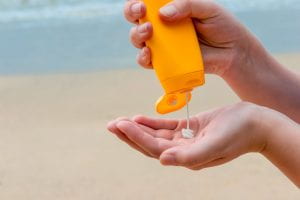If you follow health and wellness news, you have probably seen the building hype this year about sunscreen. Popular news outlets have been questioning if the ingredients in sunscreen pose health threats. One even questions whether sunscreen is the new margarine? (Many margarines – developed to encourage people to avoid the saturated fats in butter – contain transfats, which turn out to be more unhealthy than butter.)
Just last week, a small but significant study published in the Journal of the American Medical Association found that some components of sunscreens could be measured in participants’ blood up to 24 hours after application, calling into question the safety of these ingredients. (For the record, the fact that people absorb chemicals through their skin is nothing new.)
And yet, more than 3 million Americans develop skin cancer each year. Our understanding of how skin cancer develops is limited, but we do know that the only evidence-based strategy to lower its risk is to avoid skin damage from the sun. There are several ways to accomplish this: stay inside during the middle of the day, wear clothing and hats to cover your skin, and – of course – use sunscreen.
But the evidence of how well sunscreen protects against skin cancer and whether sunscreen itself is safe is mixed.
For starters, it’s difficult to study the links between sun exposure, sunscreen use and skin cancer because sun exposure across a person’s entire lifetime contributes to skin damage. By the time a participant enrolls in a study, the damage may have already occurred. In addition, it can be hard to assess how well and often study participants apply sunscreen.
Researchers categorize skin cancers into two main types: melanoma and non-melanoma. Some data show that sunscreen is more useful in preventing non-melanoma skin cancers. There is also limited evidence that sun exposure and sunburns increase one’s risk for developing melanoma, the deadliest form or skin cancer. But there are also many studies that find sunscreen does not reduce one’s risk for developing either type of skin cancer.
Despite the mixed evidence, the American Academy of Dermatology recommends sunscreen to prevent skin cancer. But which ones are the safest and work the best?
The non-profit Environmental Working Group publishes an annual sunscreen report that rates more than 1,000 sunscreens and 600 moisturizers. The products are labeled on a scale of one to ten based on industry, government and academic data sources and a review of the technical literature on sunscreens. The products are rated based on the potential health hazards associated with listed ingredients and the amount of sun protection the product offers. The report also includes an extensive online database that allows you to search for a sunscreen product.
This year’s report has some interesting observations summarized in a tip sheet for consumers. Among them:
- Don’t be fooled by high SPF. Products labeled with a high SPF only provide marginally-better protection compared to products with a lower SPF. For example, an SPF 60 sunscreen does not provide twice as much sun protection as an SPF 30 product.
- Many sunscreens include a vitamin A additive that may speed the development of skin cancer. The sunscreen industry adds a form of vitamin A called retinyl palmitate to some sunscreen products to help prevent aging. But studies show it may trigger development of skin tumors and lesions when used on skin in the presence of sunlight.
- Sunscreen doesn’t protect skin from all types of sun damage. The sun’s ultraviolet rays cause damage other than sunburns by generating free radicals that damage skin cells. Sunscreens help, but not completely. Not applying enough sunscreen, not applying frequently, and using products with poor UVA protection can lead to skin damage we cannot see with the naked eye.
- Some sunscreen ingredients affect hormone
production and cause allergies. Sunscreens are designed to penetrate the skin so they will last, but this often means they are absorbed by the body. Studies show some of the ingredients may disrupt hormone production or cause skin allergies.
The take-home message: Choosing a sunscreen that fully protects your skin from the sun without increasing your risk of other health problems can be a tricky proposition. But a little bit of research can go a long way into finding a product that is safe and effective. As long as a sunscreen is not hazardous, the evidence shows it may help lower your risk of developing skin cancer.




Speak Your Mind